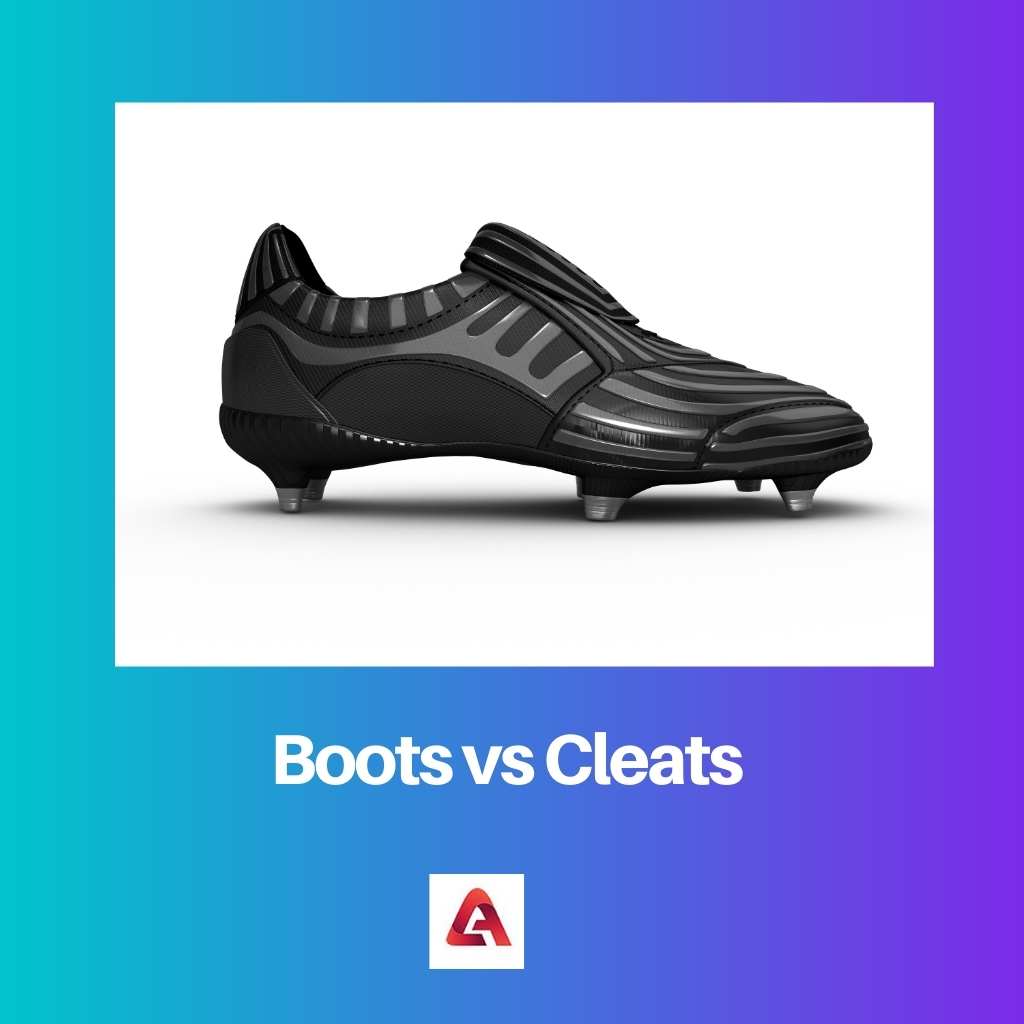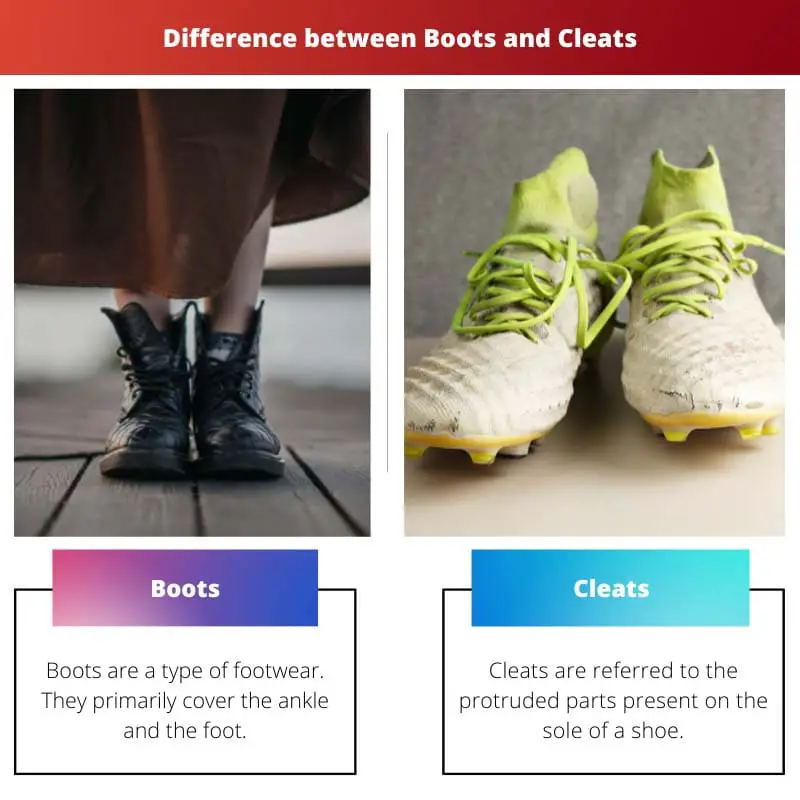Shoes are an essential part of our lives. They provide stability and support to the foot and also protect against various diseases and infections.
Depending upon the area of application, shoes can be classified into various types. The two common types are boots and cleats. Both have distinct features and are worn for different occasions.
Key Takeaways
- Boots are sturdy, supportive footwear that covers the ankle and provides protection and traction for various activities and environments.
- Cleats are specialized athletic shoes with protrusions on the sole for enhanced grip on sports fields or surfaces.
- Boots are designed for general wear and protection, while cleats are specifically engineered for improved performance in sports and outdoor activities.
Boots vs Cleats
Boots are a type of shoe that covers the foot and the ankle, and sometimes the calf or knee. Cleats are a type of athletic footwear that are designed with studs or spikes on the sole, that are intended to provide traction and prevent slipping on surfaces such as grass, dirt, or turf.

Boots are worn for fashion, style, fetish use, to protect against water, snow or mud, or in workplaces to provide safety against various hazards.
The main purpose of boots is to provide protection against rough outdoor situations and also provide height to the users.
While cleats are worn for athletic purposes, like football cleats or soccer cleats, they are not worn for fashion or style and do not protect against external hazards.
The main purpose of cleats is to provide grip on the walking surface and minimize the chances of slipping and sliding.
Comparison Table
| Parameters of Comparison | Boots | Cleats |
|---|---|---|
| Origin | The origin of boots has been around 12,000 to 15,000 BCE | The origin of cleats has been in the year 1526 |
| Types | There are numerous types of boats like Chelsea boots, hiking boots, knee-high boots, motorcycle boots, ski boots, chukka boot, combat boot, trench boot, riding boot, cowboy boot, engineer boot, and various others | Cleats can be broadly classified into four types that are metal, molded, interchangeable and turf |
| Presence of stud | Boots do not have stud near the big toe | Cleats have stud near the big toe to allow traction |
| Grip on the surface | Boots have a comparatively lower grip on the surface | Cleats provide superior grip on the surface |
| Country of origin | Spain | United States |
What is Boots?
Boots are a type of footwear. They primarily cover the ankle and the foot. Boots that extend upwards can cover the lower calf, knee, and even the hip in some types.
The heel present in the boot is distinguishable from the entire sole of the shoe. Initially, boots were only made of rubber or leather, but now a variety of materials are used in the manufacture of boots.
Boots are worn for style as well as for functionality. It protects from mud, water, bites of insects and animals, infectious diseases, and extreme temperatures.
Some boots have additional steel toes to minimize the blunt hazards, support in the ankle area, and the presence of hobnails in the underside to increase the durability of the boot in harsh conditions.
Boots are also a part of various uniforms, like workers on construction sites, to ensure safety. Various motorcycle riders are also recommended to wear boots during riding.
Boots that are worn for fashion have various accessories to decorate the boot, like boot bracelets, boot harnesses, boot bolos, boot chains, and bootstraps.
Boots are also used as formal wear and are commonly termed as dress boots. Boots are also used as a symbol in heraldry. A boot is displayed in the heraldic left field in the municipality of the court of arms of Aresches of France.
The significance of boots is that they have been used by riders for millennia and also Have been used by medieval Knights.

What is Cleats?
Cleats are referred to as the protruded parts present on the sole of a shoe. These external attachments in the shoe are beneficial in providing additional traction on a surface that is slippery or soft.
The spikes present on the sole of cleats can be blade-like or conical in shape. They are made of various materials like rubber, plastic, or even metal.
The type of cleats worn by various users directly depends on the environment and atmosphere of the play, like artificial turf, ice, grass, or other kinds of grounds.
The usage of the term cleats in American English is synecdochical to shoes that feature protrusions in the soles.
Historically it is considered that Roman legionaries had similar studded sandals. Such sandals were known as caligae and they were heavily soled and hobnailed.
The main purpose of caligae was as military sandal boots. It was in the 1500s when athletes started wearing cleats. The first fleet in athletics was in 1526 as football boots.
The most widely used cleats are firm ground cleats which are designed for natural surfaces like grass and dirt. The studs present on these cleats are large and prevent the shoe from sliding.
They provide active assistance in the rapid change of direction. The studs are permanently attached to the shoe. However, there are various detachable cleats also available like cycling cleats, golf shoes, football studs, and logger boots.

Main Differences Between Boots and Cleats
- Boots are not a type of athletic shoes, while cleats are a type of athletic shoes.
- Boots do not have spikes or studs on the sole of the shoes, while cleats have spikes or studs on the sole of the shoes.
- Boots may or may not provide height, while cleats do not provide any height to the users.
- Boots are comparatively heavyweight, while cleats are lightweight.
- Boots protect the users, while cleats aim to provide speed and agility to the users.

- https://www.tandfonline.com/doi/abs/10.1080/00918369.2011.563654
- https://www.sciencedirect.com/science/article/pii/S1268773110000512
